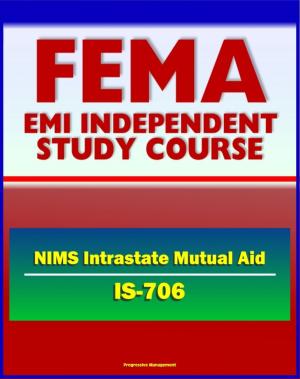Air Force Doctrine Document 3-40: Counter-Chemical, Biological, Radiological, and Nuclear Operations (CBRN) - Proliferation Prevention, Strategic Enablers, Detection and Monitoring
Nonfiction, History, Military, Biological & Chemical Warfare, Nuclear Warfare| Author: | Progressive Management | ISBN: | 9781476334240 |
| Publisher: | Progressive Management | Publication: | April 18, 2012 |
| Imprint: | Smashwords Edition | Language: | English |
| Author: | Progressive Management |
| ISBN: | 9781476334240 |
| Publisher: | Progressive Management |
| Publication: | April 18, 2012 |
| Imprint: | Smashwords Edition |
| Language: | English |
Air Force commanders and personnel must be able to prevent an attack of chemical, biological, radiological, and nuclear weapons and be able to counter the resulting effects if such weapons are used. Air Force procedures and training must be developed with joint operations in mind. Airmen must understand how to organize Air Force forces and how to present them to the joint force commander to ensure safety and survivability for all personnel while ensuring mission accomplishment. This Air Force doctrine document details principles for conducting counter-chemical, biological, radiological, and nuclear operations. Topics covered include strategic enablers, proliferation prevention, detect and monitor, denial and interdiction, passive defense (sense, shape, shield, and sustain. Contents: Chapter One - Chemical, Biological, Radiological, and Nuclear Operational Environment * Chapter Two - Proliferation Prevention Operations * Chapter Three - Counterforce Operations * Chapter Four - Active Defense Operations * Chapter Five - Passive Defense Operations * Chapter Six - Consequence Management Operations * Chapter Seven - Support Operations * Chapter Eight - Counter-Chemical, Biological, Radiological, and Nuclear Education, Training, and Exercise.
The threat or use of chemical, biological, radiological, or nuclear weapons by hostile regimes and terrorists represents one of the most difficult challenges facing our nation and our Air Force. This challenge is further complicated by the advance of technologies used to develop and deliver these weapons, making it possible for our enemies to attack us at a time and place of their choosing, with little or no warning. Success in defending our nation, our military forces, and partners and allies depends on how effectively we apply air, space, and cyberspace power to counter this threat.
Many of our adversaries are actively seeking or already possess weapons of mass destruction and have stated their willingness to employ them. The key to successful protection against this threat is our people and their dedication to this vital mission. This doctrine document describes the Air Force's role in countering the threat or use of chemical, biological, radiological, and nuclear weapons at the operational level of war. Our Air Force has tremendous capability available to address this challenge. We now use five pillars to describe how to counter these weapons: proliferation prevention, counterforce, active defense, passive defense, and consequence management. This doctrine document provides guidance for understanding, planning, and executing counter-chemical, biological, radiological, and nuclear operations to enable US forces to survive and operate effectively in this deadly environment.
Air Force commanders and personnel must be able to prevent an attack of chemical, biological, radiological, and nuclear weapons and be able to counter the resulting effects if such weapons are used. Air Force procedures and training must be developed with joint operations in mind. Airmen must understand how to organize Air Force forces and how to present them to the joint force commander to ensure safety and survivability for all personnel while ensuring mission accomplishment. This Air Force doctrine document details principles for conducting counter-chemical, biological, radiological, and nuclear operations. Topics covered include strategic enablers, proliferation prevention, detect and monitor, denial and interdiction, passive defense (sense, shape, shield, and sustain. Contents: Chapter One - Chemical, Biological, Radiological, and Nuclear Operational Environment * Chapter Two - Proliferation Prevention Operations * Chapter Three - Counterforce Operations * Chapter Four - Active Defense Operations * Chapter Five - Passive Defense Operations * Chapter Six - Consequence Management Operations * Chapter Seven - Support Operations * Chapter Eight - Counter-Chemical, Biological, Radiological, and Nuclear Education, Training, and Exercise.
The threat or use of chemical, biological, radiological, or nuclear weapons by hostile regimes and terrorists represents one of the most difficult challenges facing our nation and our Air Force. This challenge is further complicated by the advance of technologies used to develop and deliver these weapons, making it possible for our enemies to attack us at a time and place of their choosing, with little or no warning. Success in defending our nation, our military forces, and partners and allies depends on how effectively we apply air, space, and cyberspace power to counter this threat.
Many of our adversaries are actively seeking or already possess weapons of mass destruction and have stated their willingness to employ them. The key to successful protection against this threat is our people and their dedication to this vital mission. This doctrine document describes the Air Force's role in countering the threat or use of chemical, biological, radiological, and nuclear weapons at the operational level of war. Our Air Force has tremendous capability available to address this challenge. We now use five pillars to describe how to counter these weapons: proliferation prevention, counterforce, active defense, passive defense, and consequence management. This doctrine document provides guidance for understanding, planning, and executing counter-chemical, biological, radiological, and nuclear operations to enable US forces to survive and operate effectively in this deadly environment.















